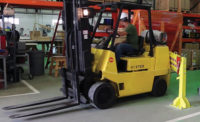The wired loading dock
Light-based communications improve safety

LED-light based systems
Fortunately, dock communication systems have seen great advances in recent years, with the development of LED-light based systems that clearly signal when it’s safe for the lift truck operator to begin unloading or loading, and when it’s safe for the truck driver to pull away from the dock after the trailer has been serviced and the vehicle is unlocked. Today’s state-of-the-art light communication systems also visually communicate to loading dock personnel if a forklift is inside a trailer. Oftentimes the lift driver’s sight line is blocked by pallets or other obstructions. These systems also include an audible alarm that sounds if the restraint is prematurely disengaged.
These communication systems are activated when an arriving truck’s trailer is locked to the loading dock. Once in place at the dock, the trailer essentially becomes an extension of the warehouse floor. However, a number of things can cause it to unexpectedly separate from the dock, which can lead to catastrophic accidents. A common type of trailer separation accident is early or unscheduled departure, which can occur when truck drivers mistakenly drive away while a forklift is entering, leaving or still inside the trailer. Another major safety threat is when trailers gradually move away from the dock due to the ongoing impact and momentum of forklifts traveling in and out of them. Eventually the dock leveler lip loses contact with the bed of the trailer and a dangerous gap results between the trailer and dock. This situation is referred to as “trailer creep,” or “dock walk.” The problem is more pronounced on trailers with air-ride suspension. It’s been shown that the bed height of air-ride trailers can fluctuate by several inches as loads are removed or added.
These are all reasons why rear impact guard (RIG)-based or wheel-based trailer restraints are superior to old fashioned “chocks.” Although they are still commonly used, chocks often don’t provide enough resistance to early pull out. Another common problem with chocks occurs when forklift operators and truck drivers get their signals crossed and mistakenly think the other person has verified that chocks are in place. The recommended practice is for forklift operators to take responsibility for their own safety and verify that the trailer is safely secured before servicing a trailer. A communication system eliminates confusion because it automatically signals when the barrier is securely engaged and it’s safe to service the trailer.
Communication systems are now integrated into most RIG and wheel-based restraints. Some restraints are equipped with advanced systems to further enhance the safety of trailer loading and unloading. These communication systems provide clear, constant communication of the restraint control box and automatically and clearly communicate the status of the restraint to both the lift truck operator and truck driver. The systems generally include sensors that detect when the trailer is present and the barrier is safely engaged; LED lights inside the dock that signal when the barrier is safely engaged, and it’s safe for the lift truck operator to begin unloading or loading; and LED lights outside the dock that signal when loading or unloading is completed and it’s safe for the driver to pull away.
Communication systems follow a logical sequence that provides a clear, visual message to the forklift operator and truck driver. Once the restraint is safely engaged, the light on a control panel inside the dock automatically changes from red to green to indicate when trailer servicing can begin. The light outside turns red, signaling to the truck driver not to pull away.
Some restraints can be equipped with advanced systems to further enhance the safety of trailer loading and unloading. In addition to performing the same functions as a traditional communication system, the most recent technology utilizes lights around the corners of the dock doors, providing clear communication of the restraint status directly in the forklift driver’s line of sight — free of any visual obstructions. It also offers lights at the rear of the leveler to confirm the status of the restraint to the forklift operator where he is most at risk — inside of the trailer.
The communication systems of restraints are often incorporated into a single dock control system that integrates multiple loading dock components, including the leveler and door. Interconnected or interlocked components ensure proper sequencing of the equipment for added safety and productivity.
Forklift safety focus
In summary, these state-of-the-art systems provide light-based communications to the lift driver outside of the trailer (both in obstructed vision situations and non-obstructed), the lift driver inside the trailer, pedestrians nearby (in the warehouse), and pedestrians and truck driver outside the warehouse and near the dock. Systems are engaged automatically when the restraint is engaged and a warning buzzer goes off if the lock gets unlocked.
Light communication systems mark a significant advance in loading dock safety, yet they cannot replace forklift and loading dock safety policies. Employers must continue to focus on forklift safety training and consider the use of multiple safety devices, such as strategically placed signs, painted aisles, and guarded walkways. However, light-based communications systems should be at the heart of any loading dock safety initiative.
Looking for a reprint of this article?
From high-res PDFs to custom plaques, order your copy today!




